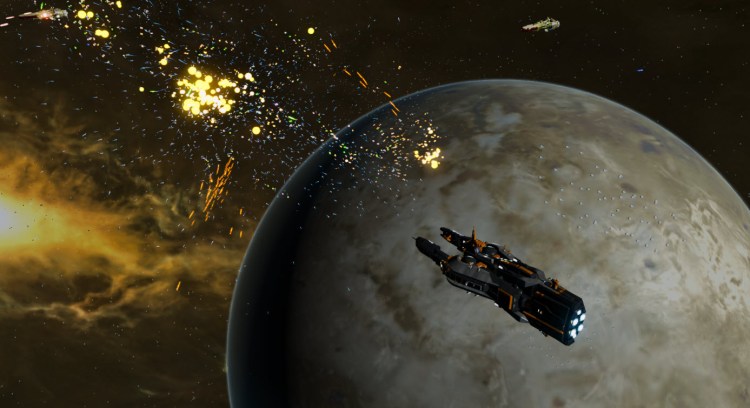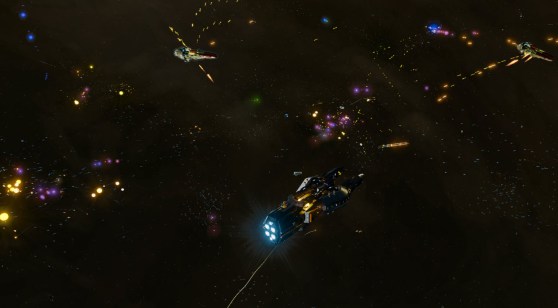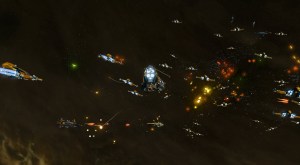GamesBeat: Now that you’ve been able to do this demo, what are you thinking about for the future?
Kipp: We’re interested in releasing the demo to the public. That’s going to be a lot of fun. All the data files we’re going to ship with should allow people to mod it. We’re accepting .SBX files. Part of what we’re looking at doing right now is some basic documentation for modders if they want to play with it. Going forward, we’re trying to consider what we’d like to do to Star Swarm next.
At the same time, we’re not developing the Nitrous engine in a vacuum. We have two licensees that we’re currently working with, and we’re also working on our own internal project at Oxide. We haven’t announced that yet, but we’ll release more about it some time in the future. We have a lot of wheels in motion.
GamesBeat: What is this engine good for, besides a great big space battle? What else could you envision as far as different genres where it could make a difference?
Kipp: We’ve only shown off a lot of the space stuff right now, but honestly, any sort of open-world game or sandbox game — in an RPG, item count is one of those things that often comes up a lot. Look at Skyrim. If you go into the options panel, you can set things like the object draw distance and tailor it in to your system. Essentially, you’re trying to scale back the number of things that have to be drawn in the world. Nitrous opens up the idea that if you’re building an intricate RPG world, all of a sudden you don’t have to have all those sliders for, say, grass distance or object distance or character distance. There’s a lot of neat stuff there.
Right now we’re building three different games, and they’re all going to be very different — anything from a traditional strategy game, like a Civilization, to an RTS game like Company of Heroes, or a StarCraft even. Those would be very exciting games to make with Nitrous. You get a ton more flexibility as far as how you want to build those characters.
GamesBeat: Do you have any timing in mind for any of these things, like when you might release it for modding?
Kipp: We’re still targeting the first quarter of this year. We’re waiting on a few logistical elements to finish up. The demo is pretty stable, or I should say standard. We’re not working on making many changes at this point. We’re just waiting for our partners to finish up and give us the go-ahead to release that. As always, it’s a mix between the developer and, in this case, everyone else that’s working together on this.
GamesBeat: Do you face any challenges developing for Mantle and developing for Nvidia and Intel platforms as well? Is the cross-platform issue a challenge?
Kipp: What’s interesting is that all three of them are making great hardware. [Laughs] I don’t mean that to sound like a cop-out. For what we’ve seen, the big difficulties tend to be the software layers between us and the hardware. But no, Nvidia’s been great about their DirectX support. Intel, in the same way, their DirectX support has been good. There hasn’t been much of a challenge there.
What becomes challenging is when hardware feature sets aren’t consistent, or performance feature sets. That’s where it starts to be problematic. But we haven’t had any trouble at all. I would expect that a DirectX implementation – or if Nvidia ever decides to support Mantle – would be on par.
GamesBeat: If you get some next-generation chips – things that might hit in the next year or so — along with software improvements like Mantle, what do you predict might be possible?
Kipp: One thing that’s we see as unexplored territory, which a lot of people are just getting into, is the asynchronous compute that’s been talked about. That’s where not only are you sending graphics commands to the GPU in a listed-command fashion, but you can also submit other compute work to be done by the GPU at the same time. Then the GPU will schedule that in there.
One of the things we think is neat is that both AMD and Intel are shipping a GPU alongside their CPUs at the same time now. Part of what I think is going to be interesting for the future is that game developers will start looking at, “Well, if I have a discrete card, and I’ve also got this integrated GPU compute, how can I use both of them at the same time?” That’s going to be interesting. The integrated GPU could become a new math coprocessor or something else. We could run physics simulations. We could run particle fluid simulations. A lot of things could be done with that added chip. It’s going to be an interesting time for gamers.
VentureBeat's mission is to be a digital town square for technical decision-makers to gain knowledge about transformative enterprise technology and transact. Learn More














![Reblog this post [with Zemanta]](http://img.zemanta.com/reblog_e.png?x-id=d457c671-4087-433a-892d-4620b5afef12)
